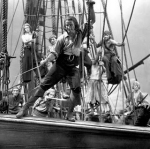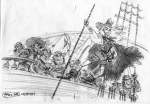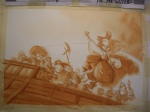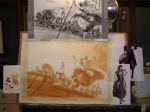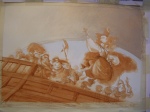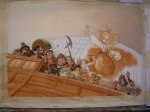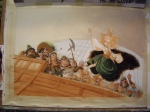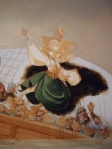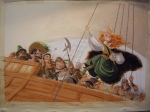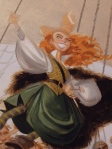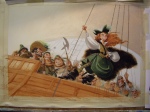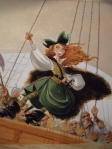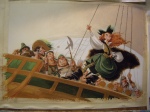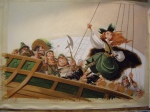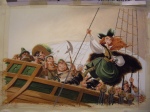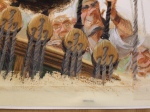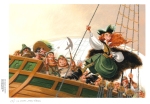new posts in all blogs
Viewing: Blog Posts Tagged with: Elizabeth, Most Recent at Top [Help]
Results 1 - 10 of 10
How to use this Page
You are viewing the most recent posts tagged with the words: Elizabeth in the JacketFlap blog reader. What is a tag? Think of a tag as a keyword or category label. Tags can both help you find posts on JacketFlap.com as well as provide an easy way for you to "remember" and classify posts for later recall. Try adding a tag yourself by clicking "Add a tag" below a post's header. Scroll down through the list of Recent Posts in the left column and click on a post title that sounds interesting. You can view all posts from a specific blog by clicking the Blog name in the right column, or you can click a 'More Posts from this Blog' link in any individual post.
By: johnmanders,
on 8/13/2014
Blog:
John Manders' Blog
(
Login to Add to MyJacketFlap)
JacketFlap tags:
pirates,
illustration,
art,
sketches,
character design,
book promotion,
Elizabeth,
irish,
ireland,
illustration process,
queen,
pirate,
costume,
underpainting,
mayflower,
thumbnail,
Add a tag

By: Alice,
on 1/23/2012
Blog:
OUPblog
(
Login to Add to MyJacketFlap)
JacketFlap tags:
Medical Mondays,
elizabeth,
This Day in History,
blackwell,
*Featured,
higher education,
geneva,
Health & Medicine,
this day in world history,
clinic,
Elizabeth Blackwell,
infirmary,
1849,
zakrzewska,
blackwell’s,
women,
doctor,
Add a tag
This Day in World History
January 23, 1849
Elizabeth Blackwell Becomes First Woman to Receive a Medical Degree

Source: National Library of Medicine
On January 23, 1849, Elizabeth Blackwell strode to the front of the Presbyterian church in Geneva, New York, to receive her diploma from Benjamin Hale, president of Geneva Medical College. The ceremony made Blackwell — who graduated first in her class — the first woman in the modern world to receive a medical degree.
Blackwell was born to a wealthy and progressive-minded English family that moved to the United States in the 1830s, when she was around ten. She became a teacher, though that profession did not engage her. One day, a dying friend told her that she might have endured her disease better if she had been attended by a female physician. The conversation planted the idea of becoming a doctor in Blackwell’s mind.
She received some rudimentary training in medicine in the home of a local physician and began applying to medical school. Geneva accepted her, in part because the student body — to whom the question of her admission had been put — treated the idea of a female medical student as a joke. Blackwell faced the hostility of some teachers, students, and townspeople, though she eventually disarmed critics with her dedication and seriousness.
Prejudice made it difficult for Blackwell to establish a practice after her graduation. In 1853, she opened a clinic for women in New York City. She was eventually joined by her sister Emily and by Marie E. Zakrzewska, both of whom she had encouraged to earn medical degrees. The clinic grew and in 1857 was renamed the New York Infirmary for Women and Children. Eleven years later, Blackwell opened the Woman’s Medical College associated with the infirmary. In 1869, she returned to England, where she lived and worked for the rest of her life.
“This Day in World History” is brought to you by USA Higher Education.
You can subscribe to these posts via RSS or receive them by email.



By: Kirsty,
on 11/17/2011
Blog:
OUPblog
(
Login to Add to MyJacketFlap)
JacketFlap tags:
elizabeth,
royalty,
This Day in History,
elizabeth I,
tudor,
throne,
British history,
*Featured,
higher education,
this day in world history,
Queen Elizabeth I,
british monarchy,
boleyn,
hatfield,
bess—ruled,
History,
UK,
queen,
lawn,
catherine,
Add a tag
This Day in World History
November 17, 1558
Elizabeth I becomes England’s Queen
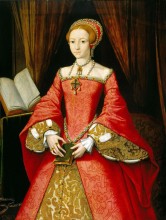 The twenty-five-year-old princess was seated beneath an oak tree on the lawn of her home, Hatfield House. Suddenly, several courtiers hurried across the lawn until they reached her location, stopped, and bowed. The queen has died, they told her. You are now queen of England. Young Elizabeth, it is said, fell to her knees and quoted a line from Psalm 118: “It is the Lord’s doing, and it is marvelous in our eyes.”
The twenty-five-year-old princess was seated beneath an oak tree on the lawn of her home, Hatfield House. Suddenly, several courtiers hurried across the lawn until they reached her location, stopped, and bowed. The queen has died, they told her. You are now queen of England. Young Elizabeth, it is said, fell to her knees and quoted a line from Psalm 118: “It is the Lord’s doing, and it is marvelous in our eyes.”
Elizabeth I, daughter of King Henry VIII by his second wife, Anne Boleyn, had reached the throne by a more circuitous path than most monarchs. Her father’s first wife, Catherine of Aragon, had born a daughter, Mary, but no son. Frustrated, Henry had broken with the Catholic Church and formed the Church of England so he could divorce Catherine and marry Anne Boleyn. After she bore Elizabeth and a stillborn son, Boleyn was beheaded for adultery—a trumped-up charge—when Elizabeth was but three. Henry then married Jane Seymour, who finally produced a male heir, the prince Edward.
Much of Elizabeth’s childhood and youth were difficult and spent away from court because her father rejected her. When he died and Edward came to the throne, she soon fell under suspicion of complicity in a plot to overthrow him. Her careful response to questions saved her. When Edward died, Mary came to the throne. She tried to restore the Catholic Church, leading to several Protestant rebellions, which led the queen to throw her half-sister into the Tower of London for a few months and eventually send her to Hatfield under house arrest.
Everything changed on that November day, however. Two months later, on January 15—a day chosen in part for its astrological promise—she had her official coronation at Westminster Abbey. Elizabeth I, called Gloriana—and Good Queen Bess—ruled for nearly 45 years and gave her name to an age.
“This Day in World History” is brought to you by USA Higher Education.
You can subscribe to these posts via RSS or receive them by email.



By: Kirsty,
on 1/14/2011
Blog:
OUPblog
(
Login to Add to MyJacketFlap)
JacketFlap tags:
Reference,
Video,
Avatar,
words,
elizabeth,
twitter,
etymology,
twitterati,
researching,
vimeo,
elizabeth knowles,
word histories,
how to read a word,
knowles,
*Featured,
Lexicography & Language,
podularity,
skulduggery,
16857473,
16856197,
16855788,
Add a tag
Historical lexicographer Elizabeth Knowles introduces her new book, How to Read a Word, which aims to introduce anyone with an interest in language to the pleasures of researching word histories. Previously I brought you an interview filmed by George Miller of Podularity, in which she suggested some ways to get started with word research. In the following three videos, Elizabeth gives us three one minute word histories. Click here to read more by Elizabeth Knowles.
On ‘avatar’:
Click here to view the embedded video.
On ‘Twitterati’:
Click here to view the embedded video.
On ’skulduggery’:
Click here to view the embedded video.


By: Kirsty,
on 1/12/2011
Blog:
OUPblog
(
Login to Add to MyJacketFlap)
JacketFlap tags:
researching,
vimeo,
elizabeth knowles,
word histories,
george miller,
how to read a word,
knowles,
*Featured,
Lexicography & Language,
podularity,
filmed by,
16866738,
histories,
Reference,
Video,
language,
words,
Dictionaries,
elizabeth,
etymology,
Add a tag
Historical lexicographer Elizabeth Knowles introduces her new book, How to Read a Word, which aims to introduce anyone with an interest in language to the pleasures of researching word histories. In this interview filmed by George Miller of Podularity in the library here at Oxford University Press in the UK she suggests some resources and techniques to get you started. Click here to read more by Elizabeth Knowles, and check back tomorrow for some of her One Minute Word Histories.
Click here to view the embedded video.


By: LaurenA,
on 11/19/2009
Blog:
OUPblog
(
Login to Add to MyJacketFlap)
JacketFlap tags:
hair pulling,
with,
Elizabeth Lambert,
Laura Pappano,
New Mexico soccer,
Playing with the Boys,
Pappano,
Lambert,
pulling,
the,
Politics,
Boys,
Current Events,
Mexico,
hair,
A-Featured,
Media,
Elizabeth,
soccer,
Laura,
New,
Playing,
Leisure,
sportsmanship,
Add a tag
Lauren, Publicity Assistant
Laura Pappano, co-author with Eileen McDonagh of Playing With The Boys: Why Separate Is Not Equal, is an award-winning journalist and writer-in-residence at Wellesley Centers for Women at Wellesley College. She blogs at FairGameNews.com . In the original post below, Pappano discusses Elizabeth Lambert’s hair-pulling and sportsmanship in women’s athletics. Read Pappano’s previous OUPblog posts here.
Outrage over New Mexico soccer player Elizabeth Lambert’s dirty play – including her ponytail-yanking an opponent to the ground – is justified given this egregious act of poor sportsmanship.
But as the conversation and video have gone viral – from SportsCenter to NFL pre-game shows to David Letterman – the subtext has become less about comportment and more about the gendered expectations of female athletes.
Guys fighting in sports – whether ice hockey or baseball – is considered a “natural” by-product of intense play and, well, testosterone. They can’t help it. When women get heated in competition (ask any high school female athletes about trash talking and you’ll get an earful) there is a perception that they’re supposed to act…differently.
In a season of throw-backs, you can add this to the list: Just as our grandmothers insisted that girls don’t sweat, they “perspire,” there remains a narrow range of acceptable behavior for female athletes. Such rigidity is not new (in previous eras women basketball players were required to wear makeup in competition and submit to half-time beauty contests), but until Lambert we had thought the rules had evolved – at least a little.
The increasing skill level and intensity of women’s sports even at high school and college levels should not be a surprise to anyone who has been paying attention. Problem is, of course, many have not been paying attention. Women’s sports remain poorly covered by the mainstream male sports media. News outlets hardly feel obligated to report on even major events (it took digging to get the result of the WNBA final). And chatter about Lambert on sports talk radio last week on the Boston station I listen to was preceded by the admission that “we have never talked about women’s college soccer on this program and we will probably never talk about women’s college soccer again, but…”
The fact remains that while female athletes have developed skills, hard-charging attitudes and leave-it-all-on-the-field seriousness about their play, we still view them as grown-up girls (in ponytails) who might be doing cartwheels in the backfield if they thought they wouldn’t get caught.
Some little girl-female athlete affinity is purposeful marketing. That’s the justification for Saturday afternoon college basketball games and cheap tickets. And, certainly, why shouldn’t women’s teams, from college basketball to professional soccer build a fan base from those who can relate to them as role models? Isn’t that the NFL’s goal fulfilled when millions of boys paste Ladanian Tomlinson Fatheads on bedroom walls and wear Peyton Manning jerseys to school?
Promoting athletes as role models, of course, is always tricky. But where men get a pass for bad behavior, women draw fire.
We forgive Michael Vick, and gasp when Serena Williams screams at a line judge’s late call at the U.S. Open.
We must get past the notion that female athletes are “nice” first and good second, and women’s games should be peddled as “family fare.” It is tiring to hear enlightened men describe themselves as “supporters” of women’s sports as if they are charitable donors. No one likes dirty play. But if Elizabeth Lambert just made people see that women’s sports are highly intense, competitive, and exciting, well, good for her.


By: Megan,
on 6/30/2009
Blog:
OUPblog
(
Login to Add to MyJacketFlap)
JacketFlap tags:
A-Featured,
Dictionaries,
Elizabeth,
of,
Jonathan,
A,
dictionary,
Martin,
Elizabeth A. Martin,
Jonathan Law,
Oxford Dictionary of Law,
Law,
Reference,
Current Events,
Oxford,
Add a tag
Megan Branch, Intern
Here on the OUPblog, we’ve been posting a series of Dictionary posts so be sure to check out the ABC’s of math and education. The language of law is confusing at the  best of times, so today’s ABC’s come from the Oxford Dictionary of Law, edited by Jonathan Law and Elizabeth A. Martin. The Dictionary contains over 4,200 entries covering all types of law–from historical treaties, like the Treaty of Rome, to property law, and everything in between. Below, I’ve excerpted some terms from the “A,” “B,” “C,” and “Q,” “R,” “S” sections.
best of times, so today’s ABC’s come from the Oxford Dictionary of Law, edited by Jonathan Law and Elizabeth A. Martin. The Dictionary contains over 4,200 entries covering all types of law–from historical treaties, like the Treaty of Rome, to property law, and everything in between. Below, I’ve excerpted some terms from the “A,” “B,” “C,” and “Q,” “R,” “S” sections.
Actual total loss (in marine insurance): A loss of a ship or cargo in which the subject matter is destroyed or damaged to such an extent that it can no longer be used for its purpose, or when the insured is irretrievably deprived of it. If the ship or cargo is the subject of a *valued policy, the measure of indemnity is the sum fixed by the policy; if the policy is unvalued, the measure of indemnity is the insurable value of the subject insured.
Bench warrant: A warrant for the arrest of a person who has failed to attend court when summoned or subpoenaed to do so or against whom an order of committal for contempt of court has been made and who cannot be found. The warrant is issued during a sitting of the court.
Contra bonos mores [Latin]: Against good morals. It is a matter of controversy to what extent the criminal law should, or does, prohibit immoral conduct merely on the ground of its immorality. The tendency in recent years has been to limit legal intervention in matters of morals to acts that cause harm to others. However, there are still certain offences regarded as essentially immoral (e.g. *incest). There are also offences of conspiring to corrupt public morals (although *corruption of public morals is not in itself criminal) and of outraging (or conspiring to outrage) public decency, although the scope of these offences is uncertain.
Qualified right: A right set out in the European Convention on Human Rights that will only be violated if the interference with it is not proportionate (see PROPORTIONALITY). An interference with a qualified right that is not proportionate to the *legitimate aim being pursued will not be lawful.
Refreshing memory: A procedure in which a witness may, while testifying, remind himself of matters about which he is testifying by referring to a document made on an earlier occasion. Under the Criminal Justice Act 2003 a witness in criminal proceedings may at any stage while testifying refresh his memory from a document or transcript of a sound recording made or verified by the witness on a earlier occasion.
Soft law (in international law): Guidelines of behaviour, such as those provided by treaties not yet in force, resolutions of the United Nations, or international conferences, that are not binding in themselves but are more than mere statements of political aspiration (they fall into a legal/political limbo between these two states). Soft law contrasts with hard law, i.e. those legal obligations, found either in *treaties or customary international law (see CUSTOM), that are binding in and of themselves.

 Let's start with the Venetian costumer, Stefano Nicolao, because I was just about to write about him, but instead ran out to the supermarket before it closed. I dashed into the Billa, and who should be standing in the produce section, but Stefano Nicolao.
Let's start with the Venetian costumer, Stefano Nicolao, because I was just about to write about him, but instead ran out to the supermarket before it closed. I dashed into the Billa, and who should be standing in the produce section, but Stefano Nicolao.
Here was our conversation:
Cat: I was just about to write about you, and here you are. I was going to write that only a man with coglioni can cry in front of an audience. And everyone clapped! When you spoke about your great appreciation for your family... it made me cry, too.
 Stefano: You have to understand that I hadn't seen many of those people for 10, 20 years. And that moment... as I was speaking about my family and the culmination of 40 years of work, it just hit me...
Stefano: You have to understand that I hadn't seen many of those people for 10, 20 years. And that moment... as I was speaking about my family and the culmination of 40 years of work, it just hit me...
Cat: After your speech, after the food, right before the show, I found myself sitting in the theatre next to your aunt. She told me that your mother supports you, sacrificed for you. She said that your father supports you; your daughter loves your work; she said that your wife was your assistant. She said the entire family was involved. Your aunt said that all this family energy lifts you up, up, up... and I was so moved to hear it. Because it' s the opposite for me... and I imagined how different life would be to have the support of an entire family... to have all that extra energy instead of doing things on one's own. That's another reason why I was crying.
s the opposite for me... and I imagined how different life would be to have the support of an entire family... to have all that extra energy instead of doing things on one's own. That's another reason why I was crying.
(Stefano's made costumes for Elizabeth, The Merchant of Venice, Casanova, etc., etc.)
We spoke in further detail, and then agreed that we must shop before the store closed (it was just about to close, and we were both just beginning to shop), so I zipped off past the jams.
 HOW WE ARRIVED AT THAT CONVERSATION
HOW WE ARRIVED AT THAT CONVERSATION
I had an invitation to go to the Theatre of San Gallo to celebrate 25 years of the Nicolao Atelier di Stefano Nicolao, and then afterwards, to see Carnival The Show. I had been curious about Carnival, The Show, because I'd seen the advertising around town. To me, it sounded very touristy; not something that locals would be interested in. So, this is something I would not ordinarily attend, except that there was the Venetian costumer, Stefano Nicolao, before the dinner and the show. I honestly did not know what to expect... and I wasn't going to stay after Stefano Nicolao... except the dinner I was supposed to attend got confused, so at the last minute I decided to gulp down some food and stay for the show.
WITH THAT CAVEAT, I sampled some of the food after the mob had already gnawed at it, and I found it to be bland and ordinary, but served in attractive plastic tumbler things... Well, the appetizers were fine. There was plenty of wine/soda/water to drink. There were so many people attacking the food at the same time that I didn't try too hard to get any, but the little I got was lacking in flavor.
THE SHOW, on the other hand, I really enjoyed. It was unexpectedly good -- the actors were good; it was professional and enjoyable. It made me miss Venice and the way life used to be. It reminded me of a theatrical production I did long, long ago in Southern California. It was an outdoor dinner theatre, and I was playing the part of Karen Andre in Ayn Rand's play, The Night of January 16th. The food was equally strange... I can't remember, like a box lunch dinner, but the show itself was good in a dinner theater kind of way. (I was on trial for killing my lover and 12 people from the audience sat on stage as jurors and had to vote whether I was innocent or guilty every night.) Now, Carnival, The Show, has absolutely nothing in common with the Ayn Rand play except in terms of a dinner-theatre feeling. So, if you have ever been to a dinner theatre production in America, it is sort of like that.
There is a very thin plot, which is that the Atelier, or the studio of this costumer, is creating the costumes for Marchesa Luisa Casati, who lived in Palazzo dei Leoni, which is now the Guggenheim. She was having a grand ball, and running around declaring: "I want to be a living work of art." So, the actors are creating costumes and reminiscing. They say at the beginning that it is not in chronological order. It's a hodge-podge of Venetian history and I just LOVED it. Really. It was strangely moving. I sat next to another journalist, and we both were laughing and crying at the same times. There were lots of Venetians there that night because of Stefano Nicolao, who would not normally be there, so, it was a special night. I cannot judge how it is normally, but based on my experience, I would say: go there for the show, but don't expect great food.
It's a history of Venice show, and I think, actually, we should require ALL VISITORS to watch the show upon arrival. If they watched the show and made an effort to understand it, I am quite sure they would enjoy Venice a lot more.
Ciao from Venice,
Cat
P.S. I did immediately spot an error -- they have a printed Timeline in the program, and they say that "Venice was founded in 421 (conveniently on St.. Mark's Day, April 25)." Well, Venice (as we all know:) was founded on Friday, MARCH 25, 421 at the stroke of noon right downstairs at Rialto at San Giacometto. And another marvelous coincidence is that Stefano Nicolao, too, was born on March 25th!

By: Beth Gallaway,
on 2/26/2008
Blog:
The Hip Librarians' Book Blog
(
Login to Add to MyJacketFlap)
JacketFlap tags:
different,
like,
elizabeth,
matthews,
coco,
like,
elizabeth,
different,
matthews,
Add a tag
Matthews, Elizabeth. Different Like Coco. Candlewick Press, 2007. 32 pp. ISBN 978-0-7636-2548-1. $16.99More than anything, Coco Chanel's life story is a tale about using what you've got and and building on your strengths and resou
Leave Comment
Harvard Law School attorney Stu Rees did his thesis on comic strip syndicate contracts. Stu represented me and several other cartoonists and helped change the way syndicate contracts were written and negotiated. Here's a link to his thesis.
The Graphic Artists Guild keeps an eye on what types of contracts illustrators are having to sign. It offers a good resource for understanding contracts as well as offering some real-life contracts as examples. GAG Contract Monitor.
The Authors' Guild has Negotiating tips for nine typical contract clauses.
Famed Illustrator C. F. Payne has some strong thoughts on Work-for-Hire agreements. While hard to avoid, WFH agreements remove an illustrator's legal authorship to his or her work. You're not just selling rights, nor simply the original art, but your very claim to authorship. Not a new article but an important one, especially since Payne's career has skyrocketing (at least compared to mine!) since he wrote this article, indicating it's not necessary to sell out in order to make a living.
Our best luck is with clients who do not have a boilerplate contract. Oftentimes clients who do have a contract have "borrowed" it from someone else, rather than having an attorney draft one for them. In any case, it is better for the Illustrator to have his or her own boilerplate, often referred to as a Letter of Agreement (see GAG Contract Monitor above). This allows the Illustrator to have more control in the negotiation process, and creates a better opportunity to explain the terms for usage of rights.
It is best to grant usage rights as specifically as possible. For example, Exclusive North American print rights for one year in March 2007 issue of Passing Classical Gas magazine. After that point, all rights revert back to you.
Limit the number of unpaid revisions to one or two. Chances are this will halve your annual workload and double your income for the year! I'm only slightly exaggerating.
How do you know if you've negotiated a good deal? If afterward you don't feel like you just screwed yourself. Never be afraid to say No and ask for what you are worth.
Ted

